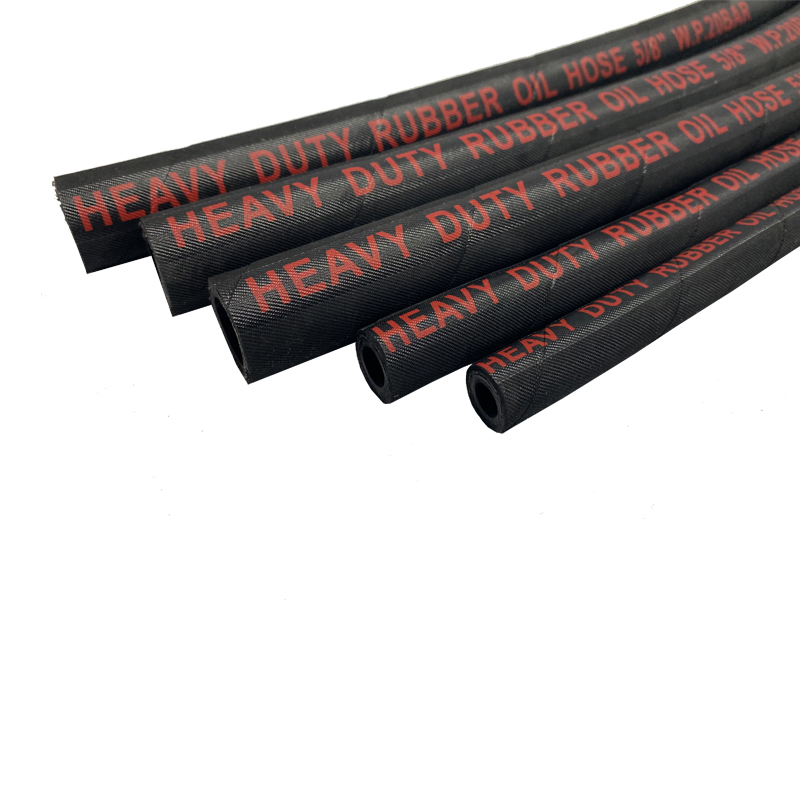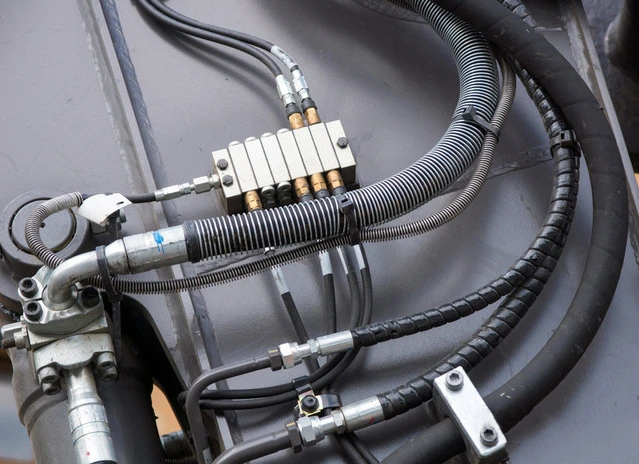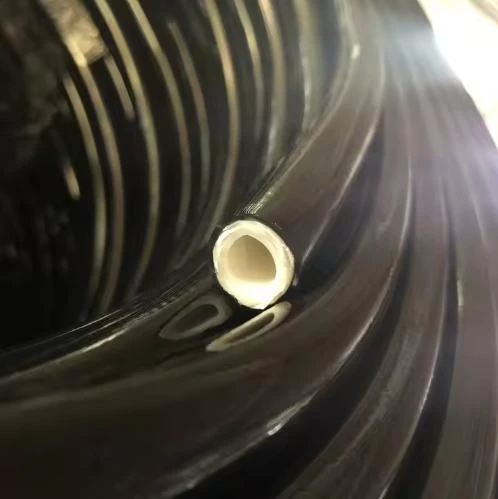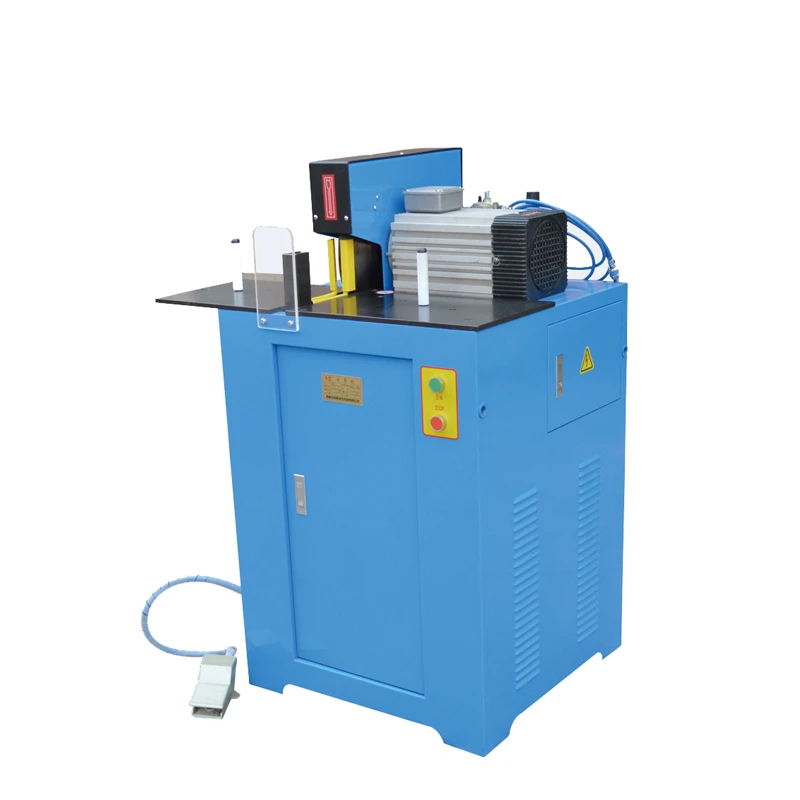ఆయిల్ హోస్
ఆయిల్ గొట్టం అనేది పారిశ్రామిక, ఆటోమోటివ్ మరియు వ్యవసాయ వ్యవస్థలలో కందెనలు, హైడ్రాలిక్ ద్రవాలు మరియు ఇంధన నూనెలతో సహా వివిధ రకాల నూనెలను బదిలీ చేయడానికి రూపొందించబడిన ఒక ప్రత్యేకమైన సౌకర్యవంతమైన గొట్టం.
చమురు నిరోధక లోపలి గొట్టాలు, దృఢమైన ఉపబలాలు మరియు మన్నికైన బాహ్య కవర్లతో నిర్మించబడిన చమురు గొట్టాలు అధిక పీడనాలు మరియు కఠినమైన పరిస్థితులను నిర్వహించడానికి మరియు వశ్యత మరియు దీర్ఘాయువును కొనసాగించడానికి రూపొందించబడ్డాయి. ఈ గొట్టాలను హైడ్రాలిక్ వ్యవస్థలు, ఇంజిన్ సరళత, ఇంధన పంపిణీ మరియు యంత్రాలు మరియు పరికరాలలో చమురు బదిలీ వంటి అనువర్తనాల్లో విస్తృతంగా ఉపయోగిస్తారు. ఉదాహరణకు, హైడ్రాలిక్ వ్యవస్థలలో, చమురు గొట్టాలు భాగాల మధ్య హైడ్రాలిక్ ద్రవం యొక్క స్థిరమైన ప్రవాహాన్ని నిర్ధారిస్తాయి, సజావుగా పనిచేయడానికి వీలు కల్పిస్తాయి. ఆటోమోటివ్ ఇంజిన్లలో, అవి సరళత మరియు శీతలీకరణ కోసం మోటారు నూనెను తీసుకువెళతాయి. పారిశ్రామిక అనువర్తనాల్లో నిల్వ ట్యాంకుల నుండి పరికరాలు లేదా పైప్లైన్లకు పెద్ద మొత్తంలో నూనెను బదిలీ చేయడం జరుగుతుంది. ట్రాక్టర్లు మరియు ఇతర చమురు ఆధారిత యంత్రాలకు శక్తినివ్వడానికి వ్యవసాయంలో చమురు గొట్టాలు కూడా అవసరం. వాటి నమ్మకమైన నిర్మాణం మరియు వివిధ చమురు రకాలతో అనుకూలత బహుళ పరిశ్రమలలో సమర్థవంతమైన మరియు సురక్షితమైన కార్యకలాపాలను నిర్వహించడానికి వాటిని అనివార్యమైనవిగా చేస్తాయి.
ఆయిల్ గొట్టాలలో ఉపయోగించే ప్రధాన పదార్థాలు ఏమిటి మరియు అవి పనితీరును ఎలా ప్రభావితం చేస్తాయి?
వివిధ చమురు సంబంధిత కార్యకలాపాలకు కీలకమైన చమురు గొట్టాలను సాధారణంగా నైట్రైల్ రబ్బరు (NBR), సింథటిక్ రబ్బరు, థర్మోప్లాస్టిక్స్ మరియు PVC వంటి పదార్థాలతో తయారు చేస్తారు, ప్రతి ఒక్కటి వివిధ రకాల చమురు గొట్టాలలో చమురు బదిలీని సమర్థవంతంగా నిర్వహించడానికి దాని నిర్దిష్ట లక్షణాల కోసం ఎంపిక చేయబడతాయి. ఉదాహరణకు, ఆయిల్ కూలర్ గొట్టాలకు తరచుగా చమురును బదిలీ చేసేటప్పుడు వేడి వెదజల్లడాన్ని నిర్వహించగల పదార్థాలు అవసరమవుతాయి. అద్భుతమైన చమురు-నిరోధక గొట్టాలను తయారు చేయడానికి ప్రసిద్ధి చెందిన నైట్రైల్ రబ్బరు, చమురు, ఇంధనం మరియు గ్రీజుకు అద్భుతమైన నిరోధకత కోసం విస్తృతంగా ఉపయోగించబడుతుంది, ఇది ఆటోమోటివ్ మరియు పారిశ్రామిక అనువర్తనాలకు అనువైనదిగా చేస్తుంది.
సింథటిక్ రబ్బరు ముఖ్యంగా అధిక పీడన వాతావరణాలలో మెరుగైన వశ్యత మరియు మన్నికను అందిస్తుంది, అదే సమయంలో వృద్ధాప్యం మరియు పగుళ్లను కూడా నిరోధిస్తుంది. ఒత్తిడిలో వాటి సమగ్రతను కాపాడుకోవాల్సిన చమురు పీడన గొట్టాలకు ఇది గొప్ప ఎంపికగా చేస్తుంది. థర్మోప్లాస్టిక్ పదార్థాలు తేలికైన నిర్మాణం మరియు రాపిడి మరియు పర్యావరణ కారకాలకు నిరోధకతను అందిస్తాయి, ఇవి పోర్టబుల్ లేదా అవుట్డోర్ అప్లికేషన్లకు అనుకూలంగా ఉంటాయి.
PVC సాధారణంగా సాధారణ ప్రయోజన చమురు గొట్టాల కోసం ఉపయోగించబడుతుంది, ఎందుకంటే దాని సరసమైన ధర మరియు బహుముఖ ప్రజ్ఞ కారణంగా, కానీ తీవ్రమైన ఉష్ణోగ్రతలు లేదా ఒత్తిళ్లలో బాగా పనిచేయకపోవచ్చు. తక్కువ డిమాండ్ ఉన్న వాతావరణంలో ఆయిల్ గొట్టాన్ని ఉపయోగించాల్సిన సందర్భాలలో, PVC ఖర్చుతో కూడుకున్న ఎంపిక కావచ్చు. టెక్స్టైల్ బ్రెయిడ్లు, స్టీల్ వైర్ లేదా స్పైరల్ పొరలు వంటి ఉపబలాలు ఆయిల్ గొట్టం యొక్క బలం మరియు పీడన సహనాన్ని పెంచుతాయి, ఇది ముఖ్యంగా ఆయిల్ పీడన గొట్టాలకు చాలా అవసరం. పదార్థం యొక్క ఎంపిక గొట్టం యొక్క వశ్యత, ఉష్ణోగ్రత పరిధి మరియు వివిధ నూనె రకాలతో అనుకూలతను ప్రభావితం చేస్తుంది, అందరికీ నిర్దిష్ట అనువర్తనాల్లో సరైన పనితీరు మరియు దీర్ఘాయువును నిర్ధారిస్తుంది. పారిశ్రామిక గొట్టాలు.
దీర్ఘకాలిక విశ్వసనీయత మరియు భద్రతను నిర్ధారించడానికి మీరు ఆయిల్ హోస్ను ఎలా నిర్వహిస్తారు?
ఆయిల్ గొట్టాన్ని నిర్వహించడంలో క్రమం తప్పకుండా తనిఖీలు, సరైన నిర్వహణ మరియు వైఫల్యాలను నివారించడానికి మరియు దాని సేవా జీవితాన్ని పొడిగించడానికి కార్యాచరణ మార్గదర్శకాలకు కట్టుబడి ఉండటం అవసరం. పగుళ్లు, లీకేజీలు, బొబ్బలు లేదా రాపిడి వంటి దుస్తులు సంకేతాల కోసం గొట్టాన్ని కాలానుగుణంగా తనిఖీ చేయండి, ముఖ్యంగా ఫిట్టింగ్లు మరియు వంపుల చుట్టూ, ఎందుకంటే ఈ ప్రాంతాలు ఒత్తిడికి గురవుతాయి. సిస్టమ్ వైఫల్యాలు లేదా భద్రతా ప్రమాదాలను నివారించడానికి ఏదైనా దెబ్బతిన్న గొట్టాలను వెంటనే మార్చండి. కాలక్రమేణా పదార్థాన్ని క్షీణింపజేసే చమురు అవశేషాలు, ధూళి మరియు కలుషితాలను తొలగించడానికి గొట్టాన్ని క్రమం తప్పకుండా శుభ్రం చేయండి. సరైన నిల్వ అవసరం; గొట్టాన్ని చల్లని, పొడి మరియు బాగా వెంటిలేషన్ ఉన్న ప్రదేశంలో ఉంచండి, ఇవి పదార్థాన్ని బలహీనపరిచే ప్రత్యక్ష సూర్యకాంతి, తేమ మరియు కఠినమైన రసాయనాలకు దూరంగా ఉంచండి. ఓవర్లోడింగ్ మరియు అకాల దుస్తులు నివారించడానికి గొట్టం యొక్క పేర్కొన్న ఒత్తిడి, ఉష్ణోగ్రత మరియు వంపు వ్యాసార్థ పరిమితులను మించిపోకుండా ఉండండి. ఫిట్టింగ్లు సురక్షితంగా జతచేయబడ్డాయని నిర్ధారించుకోండి మరియు కాలానుగుణంగా లీకేజీలు లేదా వదులుగా ఉండే కనెక్షన్ల కోసం తనిఖీ చేయండి. ఈ నిర్వహణ పద్ధతులను అనుసరించడం ద్వారా, మీరు నమ్మకమైన పనితీరును నిర్ధారించుకోవచ్చు, భద్రతను పెంచుకోవచ్చు మరియు మీ ఆయిల్ గొట్టం యొక్క జీవితాన్ని పొడిగించవచ్చు.
Analysis of Core Materials and Oil-Resistant Mechanisms in Oil Hoses
SINOPULSE designs high-performance oil hoses with a deep understanding of material science and fluid dynamics. The selection and engineering of core materials play a pivotal role in ensuring hoses can withstand continuous exposure to various oils without degradation. Here’s an in-depth look at the key components and their oil-resistant mechanisms that make SINOPULSE hoses the preferred choice for oil suction, transfer, and delivery applications.
Nitrile Butadiene Rubber (NBR): The Backbone of Oil Resistance
At the heart of SINOPULSE oil-resistant hoses lies Nitrile Butadiene Rubber (NBR), a synthetic elastomer renowned for its exceptional oil compatibility. NBR’s molecular structure, characterized by acrylonitrile monomers, creates a cross-linked network that repels hydrocarbon-based oils. This unique composition minimizes oil absorption, ensuring the hose maintains its physical properties—such as flexibility, strength, and sealing integrity—even after prolonged immersion. For example, in diesel fuel or hydraulic oil applications, NBR-lined hoses exhibit a swelling rate of ≤5%, far surpassing the performance of standard rubber materials.
Reinforcement Layers: Enhancing Structural Integrity
To complement the oil-resistant inner tube, SINOPULSE integrates robust reinforcement layers. High-tensile steel wire braids or synthetic fiber meshes are woven around the NBR core, providing mechanical strength and pressure resistance. These layers distribute internal pressure evenly, enabling oil transfer hoses to handle working pressures up to 40 bar (580 PSI) and burst pressures exceeding 120 bar (1740 PSI). In heavy-duty scenarios like oil tank truck loading or industrial hydraulic systems, the reinforcement prevents tube collapse and leakage, ensuring safe and efficient oil delivery.
Outer Cover: Protection Against External Threats
The outer cover of SINOPULSE oil hoses is engineered to withstand harsh environments while safeguarding the inner components. Made from abrasion-resistant synthetic rubber or thermoplastic compounds, it resists cuts, punctures, and UV degradation—common hazards in outdoor oil transfer operations. Additionally, anti-static outer layers are available for applications involving flammable oils, dissipating electrical charges to prevent ignition risks.
Advanced Formulations for Specialized Oils
For applications requiring compatibility with synthetic lubricants, biofuels, or high-viscosity oils, SINOPULSE offers oil hoses with advanced material formulations. Fluoroelastomer (FKM) liners, for instance, provide superior resistance to aggressive chemicals and high temperatures, making them ideal for aerospace or automotive manufacturing. These specialized hoses undergo rigorous testing to ensure compliance with industry standards, such as ISO 18752 for fuel hose performance.
In industries where reliable oil transfer is non-negotiable, SINOPULSE’s commitment to material innovation and engineering excellence ensures that our oil hoses deliver long-lasting performance, safety, and efficiency.
Fault Warning and Emergency Handling of Oil Hoses
As a trusted oil hose manufacturer, SINOPULSE prioritizes safety and reliability in every oil hose we produce. However, even the most durable oil resistant hoses may encounter issues over time. Understanding how to detect early signs of failure and execute proper emergency protocols is crucial for preventing costly downtime and potential hazards in oil suction, transfer, and delivery operations.
Early Warning Signs of Hose Failure
SINOPULSE recommends regular visual inspections to identify impending issues. Bulges or Swelling indicate internal pressure damage or material degradation, often caused by excessive stress or incompatible oil types. Cracks or cuts in the outer cover expose the inner layers to environmental threats, increasing the risk of leakage. Discoloration or Hardening of the hose material signals chemical breakdown, particularly if the hose has been exposed to incompatible fluids. Additionally, unusual vibrations or whistling noises during operation may suggest blockages or pressure imbalances within the oil hose.
Emergency Response Protocols
In the event of a suspected hose failure, immediate action is essential. First, isolate the system: shut off the oil supply valves and depressurize the line to prevent further leakage. If the hose is used for flammable oils, evacuate the area and prohibit any ignition sources. For minor leaks, applying a specialized hose repair tape designed for oil-resistant materials can provide temporary containment, but this is only a stopgap measure. For significant damage, replace the hose with a SINOPULSE oil transfer hose of the same specification, ensuring proper fitting and alignment to avoid future issues.
Preventive Maintenance for Longevity
To minimize the risk of emergencies, follow SINOPULSE’s maintenance guidelines. Avoid exceeding the hose’s rated working pressure and temperature range, as overloading accelerates wear. When installing oil suction hoses, ensure the bend radius meets specifications to prevent kinking. Regularly clean and lubricate connectors to maintain a tight seal, and store hoses in a cool, dry environment away from direct sunlight to slow down material aging.
With SINOPULSE’s comprehensive approach to oil hose safety, operators can confidently manage potential risks and ensure continuous, secure oil transfer in any industrial setting.












